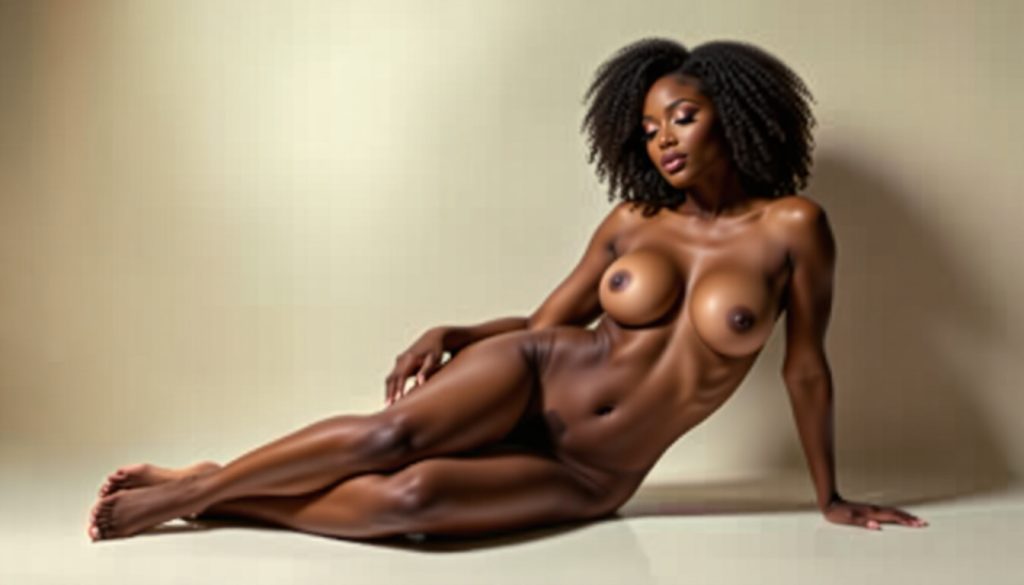The rise of NSFW AI image generators has made one thing achingly clear: people want to see themselves. Not filtered through a corporate, straight-male lens. Not reduced to a trope or fetish. But fully — and freely. At the messy, seductive, sometimes restorative intersection of queer tech and fantasy sits one of the most subversive digital niches to date: AI-generated Black lesbian porn. For some, it’s the first time they control how they appear in desire-based media. For others, it’s a reminder of how easily power can be stolen along the way. This world isn’t just about fantasy. It’s a charged battleground where pleasure, privacy, and representation collide. As AI tools evolve from clumsy sketches into jaw-droppingly realistic visuals, queer Black users are reclaiming and reframing digital space, all while dodging theft, censorship, and algorithms built without them in mind.
The Rise Of NSFW AI Tools — And The Shift From Defaults To Desire
When AI image generators first hit public servers, users noticed something disturbing pretty fast. Ask for a “beautiful woman,” and nine times out of ten, the result was thin, white, and looked dangerously close to a lingerie model from a 2003 Victoria’s Secret catalog. AI hadn’t been taught diversity — it had been spoon-fed bias. And everyone who didn’t fit the original dataset? Invisible. Or worse, mangled representations stuffed into white-coded molds.
By the current year, that changed — not by accident, but by demand. Thanks to pressure and skill-sharing within marginalized communities, today’s image generators offer tools that would’ve been unthinkable just a few years ago. The improvements aren’t just in resolution. They’re in choice.
| Feature | 2022 | the current year |
|---|---|---|
| Skin tone control | Limited or default-light | Wide hex code options or sliders |
| Body personalization | Mostly thin, hypersexualized | Realistic curves, diverse sizes |
| Hair and texture options | Straight, Eurocentric defaults | Afros, locs, kinky, relaxed styles |
| Queer couple prompts | Inconsistent or flagged | Supported and popular |
And there’s nuance even in the fantasy presets: who’s in control, who gives, who receives. These details invite users to rewrite tired scripts around dominance, submission, and emotional visibility. It’s not just about visuals. It’s about scripting attraction from scratch — with tools that finally listen.
User Search Intent And Desire: Who’s Prompting And Why
These generators aren’t just magnets for click-and-go consumers. Many users arrive with real, tender reasons — and very specific needs. For Black queer women especially, the draw is layered. It’s about safety. It’s about fantasy on their terms. It’s about actually being seen.
The most common uses coming out of community-run surveys and Discords include:
- Representation — seeing one’s own body and identity centered in erotic scenes without compromise
- Fantasy control — creating exploratory scenes that reflect specific desires, kinks, or healing dynamics
- Emotional avoidance or substitution — when real-world intimacy feels inaccessible or unsafe
This digital play can be a kind of reclamation. Queer Black femme users are not only consumers; they’re makers — offering feedback on prompts, sharing model code, and swapping data ethics tips in locked channels. They’re editing their bodies into stories with care, not for mass approval, but for deeply personal resonance.
The intersection between desire and autonomy matters here. Some users report using AI to rehearse what emotional consent might feel like during kink scenes. Others just want to fantasize about long hair, dark skin, softness, and heat — without the systemic gaze lining the walls of mainstream porn categories. It’s liberation. And it’s a little heartbreaking, too, because this kind of agency had to be stolen back pixel by pixel.
Loopholes, Prompt Engineering, And The Rogue Archives
Right now, a whole underground is archiving what mainstream AI platforms still try to bury. Forums, art co-ops, and invite-only Discord groups are swapping prompts, scripts, and detailed guides to evade automated bans and content wipes. Queer creators, especially Black femmes, know the code and know the limits — so they’re finding ways to bend both.
Instead of tagging a scene “lesbian Black women in love,” users write in layered euphemisms or use coded references only understood in those circles. Mastodon groups keep prompt recipes updated weekly, and some communities now have shared glossaries of emojis, alternative phrasing, and oblique wording that bypass filters without losing creative intent. The goal isn’t just to make porn. It’s self-preservation. It’s building archives that won’t get erased. Because when a platform deletes your body, your fantasy, your gaze… it erases a part of you, too.
When Fantasy Hurts: Dataset Exploitation and Deepfake Trauma
AI porn isn’t just about fantasy—it’s also about theft. Stolen selfies, cam model archives, and militant scraping of Tumblr-era Black queer accounts? That’s not “data”; that’s real life being fed into machines without consent. Deep learning models have quietly gobbled images of Black lesbians, femmes with box braids, big thighs, or bedroom eyes—all to generate synthetic porn under the illusion of freedom.
Platforms might ban uploading photos of real people, but that doesn’t erase the harm. Deepfake scenes mirror faces with such precision that some queer women have reported seeing their own likeness—down to signature tattoos—without ever consenting. It blurs fantasy into trauma for those whose bodies have always been a battleground.
And now, a new term’s floating around: “consent fatigue.” Because saying no 1,000 times doesn’t stop someone from feeding your look into a sexprompt generator. Even the imaginary isn’t safe anymore. What happens when someone’s fantasy is your face, your voice, your vibe—but never your permission? That sting sits deep.
Surveillance, Policing, and the Price of Visibility
Being seen means being judged—especially when algorithms are watching. Content moderation bots across major platforms still flag videos and posts from queer, Black creators. And not subtly. Users with darker skin tones or trans features report being shadowbanned just for existing shirtless, while white creators in similar poses remain untouched.
Mainstream social apps are tightening around “explicit” content, but the filters are biased. A body that’s non-normative or unapologetically proud gets policed, not celebrated. Still, communities are pushing back. Alt platforms designed by and for queer folks are popping up. Freedom here doesn’t mean exposure—it means safe space, on their terms.
Hope and Harm: What Queer Users Are Actually Saying
This tech is messy. And it’s not all bad—just complicated. When asked how AI porn made them feel, some queer Black users didn’t flinch. One said:
- “It was the first time I saw someone that looked like me being loved, not fetishized.”
- “I wanted to explore kink without trauma — the AI gave me that.”
- “They’re using our bodies for their prompts but would ban us for even posting ours.”
These aren’t contradictions; they’re truth. AI porn, especially when trained with actual consideration for Black queer realities, can give back something stolen—a sense of being desired without danger. For some, it’s the first soft space they’ve had.
But it asks a lot from people already over-stretched. To use these tools safely, you often need to join Discords, swap prompt recipes, learn what keywords protect or expose you. Healing shouldn’t require this much work. And fantasy that ends in fear isn’t fantasy at all—it’s harm in drag.
Consent in the Age of AI Porn — What the current year Looks Like
Lawmakers finally caught up. Kinda. Biometric privacy laws are hitting the books in places like California and France, and deepfake-specific laws now criminalize porn made from real faces without consent. Still, enforcement? Uneven.
Platforms offer opt-out tools. But the question is—do they work, or just look good in a press release? Community trust is thin. Some lawsuits, led by queer creators, are forcing courts to recognize digital identity as worthy of protection. These moves are slow and bruising—but they’re shifting things.
Consent shouldn’t be an afterthought. And in the current year, it’s finally making its way to the front of the conversation.








